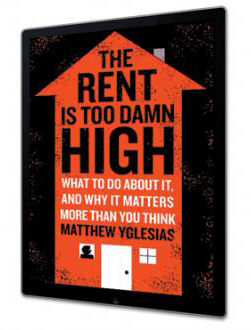|
McMillan, a “sixty-four-year-old martial arts instructor, former mailman
and self-proclaimed ‘Black Hulk Hogan’,” was a big hit on YouTube and
his riveting debate performance was parodied on Saturday Night Live.
McMillan’s message was simple and poignant:
People workin' 8 hours a and day 40 hours a
week and some a third job. Women can't afford to take care of their
children, feed their children breakfast lunch and dinner. My main
job is provide a roof over your head, food on the table and money in
your pocket. […] Listen! Someone's stomach child stomach just
growled, did you hear it? Gotta listen like me. Let's talk about the
issue! People can't afford to pay the rent are starving.
Rent is too
damn high.
Matthew Yglesias, a liberal blogger who currently
writes for Slate.com, thinks McMillan’s message needs to be taken more
seriously than most people were willing to take it, and has written a
brisk and engaging ebook arguing that the scarcity and consequent high
price of rental housing in the US is a major problem for the country’s
economy. His argument is straightforward and, to me, convincing, and it
applies equally well to the Canadian situation.
|
Why the Rent Is So Damn High |
 Yglesias agrees with McMillan that the
rent is too damn high, but he does not agree with McMillan’s proposed
solution, which is rent control. Yglesias makes short work of the idea
that rent control is a good policy for those who want the poor to be
able to afford the rent or indeed for anyone else. Simply put, rent
control works to the advantage of those who are already renting and to
the disadvantage of everyone else. It reduces or in some cases entirely
eliminates the incentive to build new rental housing and also reduces
the incentive landlords have for maintaining existing rental properties.
The resulting shortage makes it harder for would-be residents to find a
place to live, and often creates a black market where existing tenants
profit by subletting their artificially cheap dwellings at the real
market price. Therefore, new tenants end up paying more for worse and
more dilapidated housing.
Yglesias agrees with McMillan that the
rent is too damn high, but he does not agree with McMillan’s proposed
solution, which is rent control. Yglesias makes short work of the idea
that rent control is a good policy for those who want the poor to be
able to afford the rent or indeed for anyone else. Simply put, rent
control works to the advantage of those who are already renting and to
the disadvantage of everyone else. It reduces or in some cases entirely
eliminates the incentive to build new rental housing and also reduces
the incentive landlords have for maintaining existing rental properties.
The resulting shortage makes it harder for would-be residents to find a
place to live, and often creates a black market where existing tenants
profit by subletting their artificially cheap dwellings at the real
market price. Therefore, new tenants end up paying more for worse and
more dilapidated housing.
If we want to lower the rent in places where more people currently want
to live, we need to reduce demand or increase supply. Presumably we
don’t want to reduce demand if it means making those places any less
attractive. (Frankly, some anti-gentrification proposals sound like
proposals to make city neighbourhoods less attractive.) That leaves the
alternative of increasing supply. The question is: given that rents are
relatively high in many places, why hasn’t the supply of rental housing
increased to take advantage of it? There is no technological
impediment to building taller buildings. So why doesn’t the available
density of habitation increase to meet the demand? “The answer,” says
Yglesias, “overwhelmingly, is regulation.”
He goes on to express a sentiment that should ring true for many
long-suffering libertarians: “The United States of America conceives
itself as a country in love with the free market. And in some ways we
are. But there’s nothing ‘free market’ about land use in the land of the
free.” The zoning ordinances that in most places run to several hundred
pages mandate everything from the maximum height of buildings to the
amount of unbuilt land that must surround any land with a structure on
it. They mandate how much parking must be associated with each new
residence, creating a very strict upper limit on housing in areas where
underground parking is hard to construct. Cities regulate everything
down to what architectural styles are permitted. Over the years most
jurisdictions have added and added to the point where building new
high-density housing has been rendered legally—which is to say,
artificially—impossible.
|

